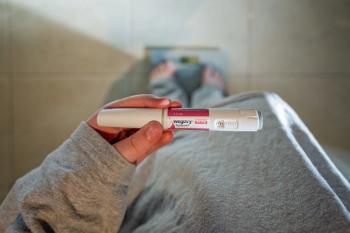
- May 2020
- Volume 90
- Issue 5
Palforzia From Aimmune Therapeutics Inc
Palforzia is an oral immunotherapy agent for the mitigation of allergic reactions, including anaphylaxis, that may occur with accidental exposure to peanuts.
THE FDA HAS APPROVED PALFORZIA (PEANUT [ARACHIS HYPOGAEA] ALLERGEN POWDER-DNFP) from Aimmune Therapeutics, Inc, to mitigate allergic reactions, including anaphylaxis, that may occur with accidental exposure to peanuts.
The medication may be initiated in patients aged 4 through 17 years with a confirmed diagnosis of peanut allergy and continued in patients 4 years and older.1 Peanut allergy affects more than 1.6 million American children and teenagers and is among the most common food allergies worldwide. Peanut reactions range from mild to potentially life-threatening, with 20% of patients with peanut allergies visiting an emergency department each year as a result of accidental exposure.2 Patients using Palforzia must continue to avoid dietary peanuts. The approval carries the limitation that Palforzia is not indicated as emergency treatment of allergic reactions, including anaphylaxis.1
PHARMACOLOGY AND PHARMACOKINETICS
Palforzia is an oral immunotherapy agent. Its mechanism of action has not been established.1
DOSAGE AND ADMINISTRATION
Palforzia is administered in 3 sequential phases: initial dose escalation, up-dosing, and maintenance. Initial dose escalation is administered on a single day under the supervision of a health care professional in a health care setting with the ability to manage potentially severe allergic reactions, including anaphylaxis. Patients who tolerate the initial escalation must return to the health care setting within 4 days to start up-dosing.
Up-dosing consists of 11 dose levels over several months. The first dose of each new level is given under the supervision of a health care professional in a health care setting able to manage potentially severe allergic reactions. If the first dose of the increased level is tolerated, the patient may continue that dose level at home. Each dose should be consumed daily with a meal at about the same time each day, preferably in the evening. After completing all up-dosing levels, the patient may begin the maintenance dose of Palforzia 300 mg daily.
Patients should be instructed not to swallow the Palforzia capsule or inhale the powder. Each capsule or sachet should be opened and entirely emptied onto semisolid food, mixed well, and completely consumed.1
CLINICAL TRIALS
Palforzia’s efficacy was evaluated in a double-blind, placebo-controlled, randomized study of 496 patients with peanut allergies. Participants completed the initial dose escalation and up-dosing to undergo 24 to 28 weeks of maintenance treatment until the study’s end. The primary efficacy end point was the percentage of participants who tolerated a single dose of 600-mg peanut protein with no more than mild allergic symptoms. The results showed that 67.2% of the Palforzia group tolerated a 600-mg dose of peanut protein compared with 4% of the placebo group.1,3
CONTRAINDICATIONS, WARNINGS, AND PRECAUTIONS
Palforzia carries a boxed warning stating that it can cause anaphylaxis, which may be life-threatening and can occur at any time during treatment. Patients using Palforzia should have and know how to use injectable epinephrine and should seek immediate medical care if epinephrine is administered. Palforzia should not be used in patients with uncontrolled asthma. Dose modifications may be necessary if an anaphylactic reaction occurs. Patients should be observed for at least 60 minutes during and after administration of the initial dose escalation and the first dose of each up-dosing level. Palforzia is available only through the Palforzia risk evaluation and mitigation strategy.
Treatment with Palforzia is contraindicated in patients with a history of eosinophilic esophagitis, other eosinophilic gastrointestinal (GI) disease, or uncontrolled asthma.
Because Palforzia can cause anaphylaxis, patients should be educated to recognize the signs and symptoms of anaphylaxis and have injectable epinephrine available. Patients with asthma should not begin Palforzia until their asthma is controlled, and treatment should be temporarily held during an acute exacerbation. Palforzia has not been studied in patients with severe asthma. The medication should be discontinued if eosinophilic esophagitis is suspected. Discontinuation of treatment or dose modification may be warranted if chronic or recurrent local GI allergic symptoms occur.
The most common adverse reactions are abdominal pain, anaphylactic reaction, cough, dyspnea, ear pruritus, nausea, oral paresthesia, oral pruritus, pruritus, rhinorrhea, sneezing, throat irritation, throat tightness, urticaria, vomiting, and wheezing.1
Monica Holmberg, PharmD, BCPS, earned her PharmD at the University of Connecticut in Storrs and completed an ambulatory care residency at the Phoenix VA Health Care System in Arizona. Her practice has also included pediatrics and inpatient mental health. She lives in Phoenix.
REFERENCES
- Palforzia. Prescribing information. Aimmune Therapeutics Inc; 2020. Accessed February 4, 2020. https://www.palforzia.com/static/pi_palforzia.pdf
- FDA approves Aimmune’s Palforzia as first treatment for peanut allergy. News release. Aimmune Therapeutics Inc; January 31, 2020. Accessed February 4, 2020. http://ir.aimmune.com/news-releases/news-release-details/fda-approves-aimmunes-palforziatm-first-treatment-peanut-allergy
- FDA approves first drug for treatment of peanut allergy for children. News release. FDA; January 31, 2020. Accessed February 4, 2020. https://www.fda.gov/news-events/press-announcements/fda-approves-first-drug-treatment-peanut-allergy-children
Articles in this issue
over 5 years ago
Interactives: Case Studies (May 2020)over 5 years ago
Pet Peeves (May 2020)over 5 years ago
Spread the Word About Medication Therapy Management Servicesover 5 years ago
Acne Can Be Troublesome But Responds to Treatmentover 5 years ago
Drug Manufacturers Must Increase Transparency During Pandemicover 5 years ago
Generic Products (May 2020)over 5 years ago
Consider Professional Development During COVID-19Newsletter
Stay informed on drug updates, treatment guidelines, and pharmacy practice trends—subscribe to Pharmacy Times for weekly clinical insights.

















































































































































































































